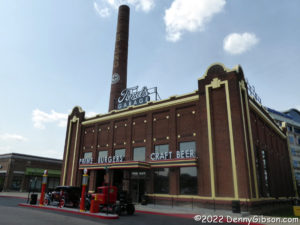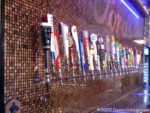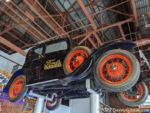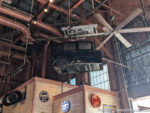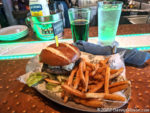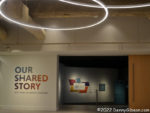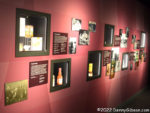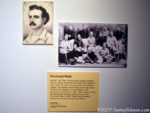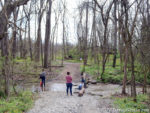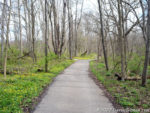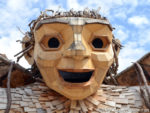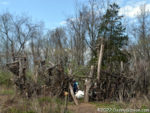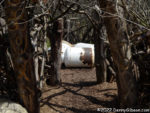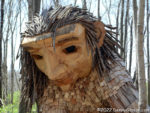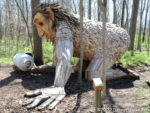 I’m on my way to a conference and it feels a little strange. The last time this happened was June 13, 2019, when I set out from home to attend the Lincoln Highway Association Conference in Rock Springs, Wyoming. I spent six days getting to that conference but will spend less than three getting to this one. The journal is here with the first day posted:
I’m on my way to a conference and it feels a little strange. The last time this happened was June 13, 2019, when I set out from home to attend the Lincoln Highway Association Conference in Rock Springs, Wyoming. I spent six days getting to that conference but will spend less than three getting to this one. The journal is here with the first day posted:
Monthly Archives: May 2022
Taste of Memory
 I don’t have a dog. Don’t need one. I can eat my own homework. I went to three different events yesterday with the intent of including all three in this post. I’m still going to do that despite the sad fact that they will not be as well documented as I planned. However, before I can even start talking about the three planned activities, I have to tell of my arrival home at the end of the day.
I don’t have a dog. Don’t need one. I can eat my own homework. I went to three different events yesterday with the intent of including all three in this post. I’m still going to do that despite the sad fact that they will not be as well documented as I planned. However, before I can even start talking about the three planned activities, I have to tell of my arrival home at the end of the day.
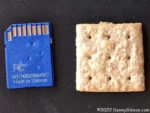 I took quite a few pictures throughout the day and popped out the memory card containing most of them as soon as I reached home. One of the day’s events had been Taste of Cincinnati with 36 restaurants and 18 food trucks. There is no reason anyone would be even slightly hungry after attending such a gathering and I really wasn’t. Nonetheless, I grabbed a few snack crackers from an open box when I walked by it on the way to my laptop. I popped one into my mouth and munched it as I picked up the laptop and headed to the table. I popped in a second one but it didn’t munch so well. It failed to crumble on the first bite so I bit it again before realizing something was terribly wrong. As I juggled laptop, memory card, crackers, and some mail I’d retrieved from the mailbox, the memory card somehow ended up in the hand with the crackers and then in my mouth. Something in it had snapped on that second munch attempt. One bite equals 68,719,476,736 bytes.
I took quite a few pictures throughout the day and popped out the memory card containing most of them as soon as I reached home. One of the day’s events had been Taste of Cincinnati with 36 restaurants and 18 food trucks. There is no reason anyone would be even slightly hungry after attending such a gathering and I really wasn’t. Nonetheless, I grabbed a few snack crackers from an open box when I walked by it on the way to my laptop. I popped one into my mouth and munched it as I picked up the laptop and headed to the table. I popped in a second one but it didn’t munch so well. It failed to crumble on the first bite so I bit it again before realizing something was terribly wrong. As I juggled laptop, memory card, crackers, and some mail I’d retrieved from the mailbox, the memory card somehow ended up in the hand with the crackers and then in my mouth. Something in it had snapped on that second munch attempt. One bite equals 68,719,476,736 bytes.
My first thought after accepting that the pictures were gone was to post something canned this week. But I had taken some pictures with my phone and those survived. There were enough, I decided, to do a stripped-down version of the three-event post I had planned. Here goes.
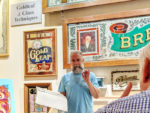
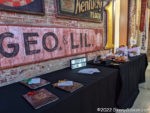 Coffee With Tod got the day started at the American Sign Museum. This was the second Saturday morning that museum founder Tod Swormstedt spent sharing some of his knowledge with museum members. During the first one, he picked a few special signs and told about their history, owners, and acquisition. Today he spoke about how “Signs of the Times” magazine has been an inspiration for and something of a predecessor of the museum. “Signs of the Times” is a sign industry trade magazine that Tod’s family was involved with from its beginning and which they owned for most of its life. In the photo, Tod is holding a hardbound copy of the very first issue from 1906. The tenth anniversary of the museum’s move to this building will be celebrated next month with an open-to-all Signmaker’s Circus.
Coffee With Tod got the day started at the American Sign Museum. This was the second Saturday morning that museum founder Tod Swormstedt spent sharing some of his knowledge with museum members. During the first one, he picked a few special signs and told about their history, owners, and acquisition. Today he spoke about how “Signs of the Times” magazine has been an inspiration for and something of a predecessor of the museum. “Signs of the Times” is a sign industry trade magazine that Tod’s family was involved with from its beginning and which they owned for most of its life. In the photo, Tod is holding a hardbound copy of the very first issue from 1906. The tenth anniversary of the museum’s move to this building will be celebrated next month with an open-to-all Signmaker’s Circus.
 Next up was the Taste of Cincinnati which was first held in 1979 and is now the longest running culinary arts festival in the country. Like many festivals, this one did not happen in 2020 or 2021 due to the COVID pandemic. As mentioned, 36 restaurants and 18 food trucks are participating in this year’s event. I took pictures of many of them and made sure to snap a photo of each one where I made a purchase. Those are all gone and the picture at left is out of sequence. It was taken after I’d done my eating and was ready to leave.
Next up was the Taste of Cincinnati which was first held in 1979 and is now the longest running culinary arts festival in the country. Like many festivals, this one did not happen in 2020 or 2021 due to the COVID pandemic. As mentioned, 36 restaurants and 18 food trucks are participating in this year’s event. I took pictures of many of them and made sure to snap a photo of each one where I made a purchase. Those are all gone and the picture at left is out of sequence. It was taken after I’d done my eating and was ready to leave.

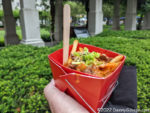 Before the festival is opened to the public, first, second, and third place offerings are picked in four categories. I limited my purchases to the four number ones. In the Soup/Salad/Side category, that was Bulgogi French Fries from YouYu. The Waygu Meatball from Council Oak Steak and Seafood placed first in the Appetizer category. Both were served from the same booth as the two restaurants are part of the Hard Rock Casino.
Before the festival is opened to the public, first, second, and third place offerings are picked in four categories. I limited my purchases to the four number ones. In the Soup/Salad/Side category, that was Bulgogi French Fries from YouYu. The Waygu Meatball from Council Oak Steak and Seafood placed first in the Appetizer category. Both were served from the same booth as the two restaurants are part of the Hard Rock Casino.

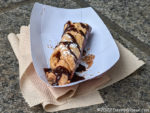 The only picture on my phone of the Entree winner was my failed attempt to get it and the Procter & Gamble towers in the same picture. I got half of the towers and the side of the container holding Alfio’s Veal Short Rib Ravioli. Pompilio’s Chocolate and Peanut Butter Cannoli won the Desert category and fared much better than the ravioli in the picture department.
The only picture on my phone of the Entree winner was my failed attempt to get it and the Procter & Gamble towers in the same picture. I got half of the towers and the side of the container holding Alfio’s Veal Short Rib Ravioli. Pompilio’s Chocolate and Peanut Butter Cannoli won the Desert category and fared much better than the ravioli in the picture department.
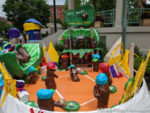
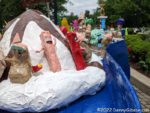
 Once I’d finished my selective sampling, I walked about a block from the festival and hopped on the streetcar to reach Washington Park. There a number of sculptures made entirely of Duck brand duct tape are on display. Named “Knock It Out of the Park”, the exhibit is all about baseball. I believe I took at least one photo of every sculpture but very few were on my phone.
Once I’d finished my selective sampling, I walked about a block from the festival and hopped on the streetcar to reach Washington Park. There a number of sculptures made entirely of Duck brand duct tape are on display. Named “Knock It Out of the Park”, the exhibit is all about baseball. I believe I took at least one photo of every sculpture but very few were on my phone.
My First May Fest
 The oldest choral festival in North America will celebrate its 150th birthday next year. It came frightfully close to reaching that awesome landmark without me ever having been present at a single performance. Both it and I were spared what would have been a truly embarrassing occurrence by my attendance on Friday. I am speaking, of course, of Cincinnati’s May Festival which was first held in 1873.
The oldest choral festival in North America will celebrate its 150th birthday next year. It came frightfully close to reaching that awesome landmark without me ever having been present at a single performance. Both it and I were spared what would have been a truly embarrassing occurrence by my attendance on Friday. I am speaking, of course, of Cincinnati’s May Festival which was first held in 1873.
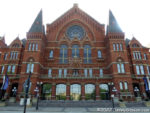 The venue was Cincinnati’s Music Hall. The festival and building have an interesting and possibly unique relationship with the event actually being responsible for the existence of the structure. Before the May Festival became an annual event in 1967 it was generally held every other year. The first two were in 1873 and 1875. Both were held in a large building called Saengerfest Hall. Rain was a minor problem in 1873 and became a major one in 1875. It wasn’t that patrons got wet but that they could not hear the music during the brief time that it fell in 1873 or the much longer period of rainfall in 1875. Amplified by the tin roof of Saengerfest Hall, the rain forced the performance to be paused. It also gave rise to a project to construct the brick building that has been home to the festival since 1878.
The venue was Cincinnati’s Music Hall. The festival and building have an interesting and possibly unique relationship with the event actually being responsible for the existence of the structure. Before the May Festival became an annual event in 1967 it was generally held every other year. The first two were in 1873 and 1875. Both were held in a large building called Saengerfest Hall. Rain was a minor problem in 1873 and became a major one in 1875. It wasn’t that patrons got wet but that they could not hear the music during the brief time that it fell in 1873 or the much longer period of rainfall in 1875. Amplified by the tin roof of Saengerfest Hall, the rain forced the performance to be paused. It also gave rise to a project to construct the brick building that has been home to the festival since 1878.
 Only one of this year’s four major performances fit into my schedule. It turned out to be probably the worst fit for my tastes. There are many things that divide the world’s population and one of them is opera. I am a member of the unappreciative group. But, even though it’s quite likely I would have enjoyed a different program more, there was much to enjoy in Friday’s performance. And I did. For one thing, I believe it was the first time I had ever watched a composer conduct his own composition. I guess John Adams conducting El Niño could be considered the black-tie version of a more-familiar-to-me performance by a singer-songwriter. As always, the Cincinnati Symphony Orchestra sounded superb and the 100+ voices of the May Festival Chorus sounded as wonderful as I’d hoped. The main chorus sat through long periods of inactivity then rose in unison to sing. Each of them held a copy of the libretto so that their risings had the appearance of a large flock of attacking seagulls. I found myself enjoying that more than I probably should have.
Only one of this year’s four major performances fit into my schedule. It turned out to be probably the worst fit for my tastes. There are many things that divide the world’s population and one of them is opera. I am a member of the unappreciative group. But, even though it’s quite likely I would have enjoyed a different program more, there was much to enjoy in Friday’s performance. And I did. For one thing, I believe it was the first time I had ever watched a composer conduct his own composition. I guess John Adams conducting El Niño could be considered the black-tie version of a more-familiar-to-me performance by a singer-songwriter. As always, the Cincinnati Symphony Orchestra sounded superb and the 100+ voices of the May Festival Chorus sounded as wonderful as I’d hoped. The main chorus sat through long periods of inactivity then rose in unison to sing. Each of them held a copy of the libretto so that their risings had the appearance of a large flock of attacking seagulls. I found myself enjoying that more than I probably should have.
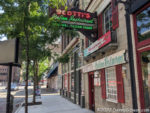
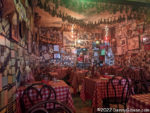
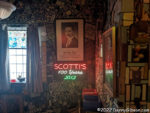 Before the concert, I walked a few blocks from Music Hall to enjoy another Cincinnati tradition. Scotti’s isn’t quite as old as the May Festival but it’s working on it. After studying the stuffed menu for some time, I went with Lasagna Ala Don Giovanni.
Before the concert, I walked a few blocks from Music Hall to enjoy another Cincinnati tradition. Scotti’s isn’t quite as old as the May Festival but it’s working on it. After studying the stuffed menu for some time, I went with Lasagna Ala Don Giovanni.
Fried or Roasted Daily
I usually try rather hard to avoid chain restaurants but here’s one I went to less than a week after it opened. Not the chain — which opened in 2012 — but the latest link. Florida-based Ford’s Garage opened its first Ohio restaurant in the former LeBlond Machine Tool Company powerhouse in Norwood on Thursday, May 5. I stopped in the following Wednesday.
The first I became aware of the chain was when I read an announcement about this one being planned for Cincinnati. Of course, any restaurant featuring ‘burgers and beers has a good chance of catching my attention but it sounded like this place had a little more going for it. It is an official licensee of the Ford Motor Company which allows it to use the Ford name and logo and it uses Ford cars for decoration. It was obviously a place I was likely to visit eventually so I decided to do it sooner rather than later.
The 1917 powerhouse, which was most recently occupied by a Don Pablo’s, is accessorized to resemble an early service station. Gas pumps and a pair of Model A Fords stand near the entrance and there is a Model T and another Model A inside. The cars and the building are of similar vintage. A Library of Congress photo shows the building when it was younger.
The building’s high ceilings allow faux Fords to circulate around the restaurant on a simulated assembly line and a stationary Model A hangs over the bar. A penny-covered wall holds forty beer taps. As I was taking the picture of the taps, a restaurant employee told me there were 21,004 pennies on the wall. I have a suspicion he made that up on the spot but I’m not sure so I’m repeating it.
Of course, it takes more than decor to make a restaurant. There’s a lot more than hamburgers on the menu but that’s sort of their featured item so that’s what I ordered. This is the quite tasty Mushroom & (Tillamook) Swiss. A couple of other things in this picture deserve mention. One is the shop towel napkin inside the hose clamp. The second is the frost-covered surface beneath the West Sixth Porter. About eight years ago I saw a similar setup in a bar in Kingman, Arizona, and figured it would be in every watering hole in the country before I got home. But this is the only other one I’ve ever seen which is not much help at all to my reputation as a futurist.
 Despite it being a chain with a plethora of gimmicks, I basically liked the place. The chain is fairly small with twenty stores in five states and the gimmicks are mostly harmless (the napkins) or cool (the cars). One gimmick, however, seemed a bit overly silly to me. I noticed the funnel behind the bar and had vague intentions of asking about it when I overheard one of the bartenders talking about it with a visiting friend. He flipped an unseen switch to open a valve in the transmission (He called it the crankcase.) that allowed some liquid to drop into the funnel and into a glass placed below it. He said it was for a drink called the “Oil Change” although I’ve found no such drink on the menu. As I said, it struck me as quite silly but who am I (a fan of Max & Erma’s double-breasted beer taps) to judge.
Despite it being a chain with a plethora of gimmicks, I basically liked the place. The chain is fairly small with twenty stores in five states and the gimmicks are mostly harmless (the napkins) or cool (the cars). One gimmick, however, seemed a bit overly silly to me. I noticed the funnel behind the bar and had vague intentions of asking about it when I overheard one of the bartenders talking about it with a visiting friend. He flipped an unseen switch to open a valve in the transmission (He called it the crankcase.) that allowed some liquid to drop into the funnel and into a glass placed below it. He said it was for a drink called the “Oil Change” although I’ve found no such drink on the menu. As I said, it struck me as quite silly but who am I (a fan of Max & Erma’s double-breasted beer taps) to judge.
Book Review
20 in ’21 and the YT Too
Denny Gibson
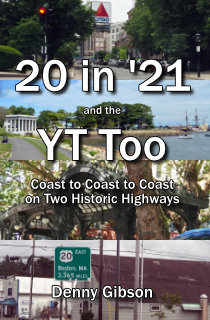 Missed it by that much. I had this really great idea for a book title, and even figured out the story that would fit it. I would drive one way across the country on the Yellowstone Trail and the other way on US 20. I would do this in the year 2020, and the resulting travelogue would be perfectly described by that catchy title: 20 in ’20 and the YT Too. But COVID-19 played havoc with 2020 travel plans and the wonderful title’s “best if used by” date came and went. I made the planned trip a year later and adjusted the title appropriately. It’s admittedly not quite the same but it’s not horrible. Is it? Well?
Missed it by that much. I had this really great idea for a book title, and even figured out the story that would fit it. I would drive one way across the country on the Yellowstone Trail and the other way on US 20. I would do this in the year 2020, and the resulting travelogue would be perfectly described by that catchy title: 20 in ’20 and the YT Too. But COVID-19 played havoc with 2020 travel plans and the wonderful title’s “best if used by” date came and went. I made the planned trip a year later and adjusted the title appropriately. It’s admittedly not quite the same but it’s not horrible. Is it? Well?
As for the trip, it certainly wasn’t horrible. It was fantastic. And the resulting travelogue isn’t horrible either. Maybe not fantastic but definitely not horrible. I think calling it pretty good is legit. It’s got pictures.
It has more pictures than any previous Denny Gibson travelogue. It would also have the most pages if you took Granny’s letters out of Tracing a T to Tampa. I’ve been saying it has nearly 200 photos. I believe the actual count is 192 and “nearly 200” sounds much more impressive than “over 190”.
Like all the previous travelogues, the pictures are black and white. I started this project intending to use Amazon’s new improved color options. I even had a proof copy printed in premium color to see how it looked. It looked good. I asked myself if I thought other people would pay $30 or more for the book and answered, “Probably not”. Then I asked myself if I would pay $30 or more for the book and again answered, “Probably not”. So I backed away from the idea of a full-color glossy-paged thing of beauty and again embraced the idea of a gray-scale matte-paged thing of practicality. However, just as with the others, there is a Kindle version with color pictures. Electronic color is free.
The subtitle is a bit misleading. The documented trip doesn’t really start on a coast. It starts in Ohio, goes to the Atlantic, then the Pacific, then back to Ohio. The book sometimes refers to this as C2C2C2C (center to coast to coast to center) but that requires way too much explanation to work as a subtitle. The pictures on the front cover do a better job of describing this sequence than the subtitle does. From top to bottom they show a sign in Boston, Plymouth Rock, Pioneer Square, and a sign in Newport. These represent the termini of the pair of historic highways in the sequence they were reached. First is US 20’s east end then the Yellowstone Trail’s east end. The Yellowstone Trail’s west end is next followed by the west end of US 20. The book covers a whole lot of traveling before that first terminus and after the last one.
In summary, the book has a cool (but not as cool as it could have been) title, tells about crossing the USA twice on historic highways, has lots of B&W (though color was considered) pictures, and has an almost but not quite true subtitle. What’s not to like?
20 in ’21 and the YT Too, Denny Gibson, Trip Mouse Publishing, 2022, paperback, 9 x 6 inches, 189 pages, ISBN 979-8422405411.
Signed copies available soon through eBay. Unsigned copies available through Amazon.
Reader reviews at Amazon and Goodreads are appreciated and helpful and can be submitted regardless of where you purchased the book. All Trip Mouse books are described here.
Our Shared Story at CMC
Joseph Jonas is thought to be the first Jew to actually settle in Cincinnati. That was in 1817. In 1821, he was one of a handful of men who purchased land for a cemetery so Benjamin Leib’s deathbed request that he be buried as a Jew could be met. The creation of that cemetery, the Chestnut Street Cemetery, is recognized as the event that formally established the Jewish community in Cincinnati. It was renovated last year and its rededication on September 26, 2021, marked the official beginning of the Jewish Cincinnati Bicentennial.
But it wasn’t a visit to the cemetery that led to this post. It was the “Our Shared Story” exhibit at the Cincinnati Museum Center that led to a visit to the cemetery. In 1821 Cincinnati really was a frontier town and the Chestnut Street Cemetery was not just the first Jewish cemetery in the state but the first west of the Alleghenies. In 1824, K.K. Bene Israel was established. Now known as Rockdale Temple, it is the oldest Jewish congregation west of the Alleghenies. Cincinnati’s Jewish community experienced great growth and had significant impact on the religion in the U.S. with things like major support for Reform Judaism and the founding of Hebrew Union College. The exhibit tells of this influence but has even more examples of the impact Cincinnati Jews had on the world at large.
Quite a number of community and business leaders are recognized. This picture is of a wall where several of those business leaders are identified. Some of the businesses are Manischewitz, Frank’s, Fleischmann’s, and Frisch’s. I got a kick out of seeing a “Jewish Cowboy” promotional record put out by Manischewitz. I got an even bigger kick out of listening to it on YouTube.
As befitting a place that started professional baseball, one Jewish business found success in sporting goods. The Cincinnati Red Stockings began play in 1869, the P. Goldsmith Sons Company was founded in 1875, and a Jewish player named Lipman Pike joined the Reds in 1877. Of course, there are now Jewish players in every professional sport and Jewish fans too as this Bengals yarmulke shows.
 Chestnut Street Cemetery is less than a mile from the museum. A double-sided plaque contains information about the cemetery and the two centuries of Jewish history. The information panel visible in the opening photo says that Benjamin Leib’s grave is unmarked but believed to be “in the back left corner”. I’m guessing that means it’s in the left rear of this picture.
Chestnut Street Cemetery is less than a mile from the museum. A double-sided plaque contains information about the cemetery and the two centuries of Jewish history. The information panel visible in the opening photo says that Benjamin Leib’s grave is unmarked but believed to be “in the back left corner”. I’m guessing that means it’s in the left rear of this picture.
Treading the Trails of Trolls
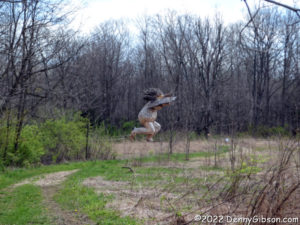 This is the second Thomas Dambo art installation I’ve visited, and, like my visit to the Kentucky Giants, waiting for good weather and available time was required. Things came together two Fridays ago, on April 22.
This is the second Thomas Dambo art installation I’ve visited, and, like my visit to the Kentucky Giants, waiting for good weather and available time was required. Things came together two Fridays ago, on April 22.
Dambo’s creations are always big, always made of repurposed material, and always have a story. “The Troll That Hatched an Egg” is installed at Aullwood Audubon near Dayton, Ohio. With Dayton being the home of the Wright Brothers, it makes sense that this story involves flying. It can be read here. Aullwood Audubon consists of a nature center and a farm with trolls in both sections. A trail connecting the two will be closed for another month or so meaning a short drive is required to see all of the trolls. Because of the distance, some may want to drive regardless.
I began my visit at the nature center. That’s kind of at odds with the storyline but that really isn’t much of a consideration. Inside the Education Center, Karen and Susan teamed up to take my money and provide me with a sticker, a map, and some insight. Karen is one of the volunteers that helped with constructing the trolls. She told me that the faces were made in Denmark and shipped to Dayton but that everything else was built on-site using materials collected before Dambo arrived. Construction took about a month. I had anticipated taking the shortcut over the creek but this group was having so much fun that I couldn’t bring myself to disturb them so took the longer — and probably safer — paved path. I did cross the creek on my return, however.
There are three trolls and a nest in the installation. Had I crossed the creek as originally planned, I would probably have seen the nest first. As it happened, my first view of any of the sculptures was the one in the opening photograph. That’s Bibbi learning to fly which is actually the climax of the story. Out of sequence or not, it’s a great first contact. The only thing comparable to Bibbi’s look of joy at flying is a kid’s look of joy at watching her do it. Karen had told me that this is the only time Dambo created a troll standing on one foot and some extra engineering was required. The observation tower was built to provide a view of the prairie but it is also a great place to see Bibbi’s launch.
I caught a glimpse of the eggs as I approached the nest and a better view as I entered from the other side. When I first saw some photos of this installation without having read any of the story, I thought that maybe these tanks were the closest Dambo could get to something that looked like a big egg. Later I realized that these tanks were just right for representing something dropped accidentally from an airplane. By the way, despite the story’s title, none of these eggs hatch. As I stood inside the nest, I took a photo that was posted to Instagram/Facebook/Twitter with the caption “One of these eggs is not like the others.” In case you missed it without wanting to, it is here.
From the nest, I headed back to the parking lot for the drive to the farm. Once there, it was an easy walk to where Bodil held another egg in her hand. Although only the beginning of my walk at the nature center had been on pavement, all of it was fairly level and clear. That was pretty much true of the walk to Bodil although there was a little more elevation change along the way. The walk to see Bo was a different matter.
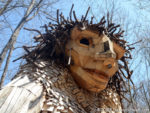
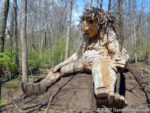 Although well under half a mile, the walk to reach Bo was the longest excursion of the day. No portion is particularly steep but there is a steady descent to the resting troll which means a steady ascent on the return. Along the way, numerous exposed roots and a few exposed rocks provide ample opportunity for tripping. I say that not to discourage going but to encourage caution.
Although well under half a mile, the walk to reach Bo was the longest excursion of the day. No portion is particularly steep but there is a steady descent to the resting troll which means a steady ascent on the return. Along the way, numerous exposed roots and a few exposed rocks provide ample opportunity for tripping. I say that not to discourage going but to encourage caution.

 These last two pictures are clearly out of sequence. They are included for different specific reasons. The etiquette sign is here so you’ll know how to behave in case this is the only thing you read before visiting Bo, Bodel, and Bibbi. The other is included in case it isn’t the only thing you read and were wondering why it did not have a full-frontal shot of Bibbi taking flight like all the others.
These last two pictures are clearly out of sequence. They are included for different specific reasons. The etiquette sign is here so you’ll know how to behave in case this is the only thing you read before visiting Bo, Bodel, and Bibbi. The other is included in case it isn’t the only thing you read and were wondering why it did not have a full-frontal shot of Bibbi taking flight like all the others.

 I decided to make it an all-troll day by stopping at the Troll Pub for the first time. The pub shares a historic building with Wheelhouse Lofts. I don’t know where conversion and occupancy of the lofts stands but the pub has been in operation for four years. I also do not know why I haven’t stopped here before given that it is barely a block from one of my favorite Dayton establishments, The Barrel House. With The Barrel House that close and my first meal there being pretty good, I do expect to return. The building was constructed in 1868 by an agricultural implement manufacturer. Its later uses included making bicycles (Stoddard) and car parts (Dayton Motor Car Company) plus the assembly of some automobiles (Courier and Maxwell). Could Jack Benny’s car have been built here?
I decided to make it an all-troll day by stopping at the Troll Pub for the first time. The pub shares a historic building with Wheelhouse Lofts. I don’t know where conversion and occupancy of the lofts stands but the pub has been in operation for four years. I also do not know why I haven’t stopped here before given that it is barely a block from one of my favorite Dayton establishments, The Barrel House. With The Barrel House that close and my first meal there being pretty good, I do expect to return. The building was constructed in 1868 by an agricultural implement manufacturer. Its later uses included making bicycles (Stoddard) and car parts (Dayton Motor Car Company) plus the assembly of some automobiles (Courier and Maxwell). Could Jack Benny’s car have been built here?

